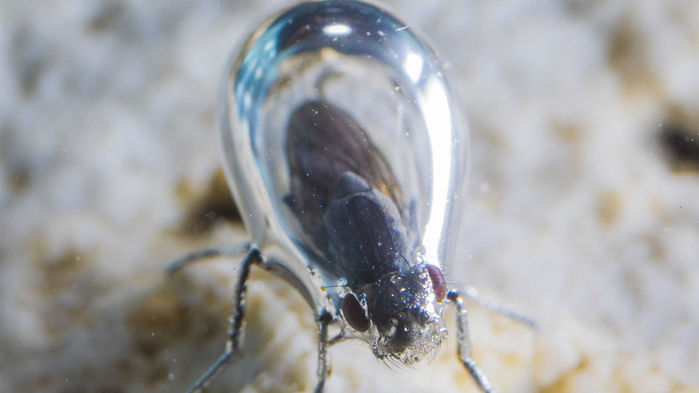
California’s Mono Lake is three times saltier—and much more alkaline—than the ocean, making it inhospitable for most life. Yet the tiny alkali fly (Ephydra hians, pictured) thrives on its surface. It even survives underwater, thanks to a bubble that forms from air trapped between the hairs covering the insect’s body. Salt makes it difficult to form bubbles, so how does the fly build this bubble in the first place? To find out, researchers collected hundreds of flies from the lake, and subjected the insect and six of its close relatives to increasing concentrations of sodium carbonate. At high levels, the salt stripped air from between the hairs of the other flies, destroying the bubble. But the alkali fly’s hairs are much more closely packed, better trapping the air and maintaining the bubble. And while all the flies have a water-repelling waxy coat, only the alkali fly’s coat can repel Mono Lake water, the team reports today in the Proceedings of the National Academy of Sciences. These adaptations have enabled the insect to feast with no competition on the lake’s algae. And that has enabled other life—like migrating birds—to live around the lake, as they feast on the flies. But this ecosystem is a risk, the researchers say. Water diversions are shrinking the lake, raising sodium carbonate concentrations to dangerously high levels, even for the alkali fly. In addition, sunscreen film from the lake’s occasional human swimmers strips the fly’s waxy coat, making it even more susceptible to drowning.
Authors get paid when people like you upvote their post.
If you enjoyed what you read here, create your account today and start earning FREE STEEM!
If you enjoyed what you read here, create your account today and start earning FREE STEEM!
Hi! I am a robot. I just upvoted you! I found similar content that readers might be interested in:
http://www.sciencemag.org/news/2017/11/fly-survives-deadly-lake-encasing-itself-bubble-here-s-how-it-makes-it
Downvoting a post can decrease pending rewards and make it less visible. Common reasons:
Submit
ok
Downvoting a post can decrease pending rewards and make it less visible. Common reasons:
Submit